UK Patient Access to Low-Protein Prescription Foods in Phenylketonuria (PKU): An Uneasy Path
Abstract
1. Introduction
2. Materials and Methods
2.1. Study Group
2.2. Questionnaire
2.3. Data Analysis and Statistics
2.4. Ethical Approval
3. Results
3.1. Study Group
3.2. Prescribing LPPF
3.3. How LPPF Are Dispensed
3.4. Dietetic Time Managing LPPF Supply
3.5. Main Issues with LPPF Supply
3.6. Frequency of Issues with LPPF
3.7. Main Issues with GP Practice
3.8. Main Issues with Pharmacies
3.9. Main Issues with Home Delivery Companies
3.10. Patient/Caregiver Issues
3.11. Summary of Issues with the Current System for Obtaining LPPF in the UK
3.12. Improvements Required
4. Discussion
Limitations
5. Conclusions
Supplementary Materials
Author Contributions
Funding
Institutional Review Board Statement
Informed Consent Statement
Data Availability Statement
Acknowledgments
Conflicts of Interest
References
- van Spronsen, F.J.; Blau, N.; Harding, C.; Burlina, A.; Longo, N.; Bosch, A.M. Phenylketonuria. Nat. Rev. Dis. Primers 2021, 7, 36. [Google Scholar] [CrossRef] [PubMed]
- Blau, N. Genetics of Phenylketonuria: Then and Now. Hum. Mutat. 2016, 37, 508–515. [Google Scholar] [CrossRef] [PubMed]
- Longo, N.; Dimmock, D.; Levy, H.; Viau, K.; Bausell, H.; Bilder, D.A.; Burton, B.; Gross, C.; Northrup, H.; Rohr, F.; et al. Evidence- and consensus-based recommendations for the use of pegvaliase in adults with phenylketonuria. Genet. Med. 2019, 21, 1851–1867. [Google Scholar] [CrossRef] [PubMed]
- Burton, B.K.; Longo, N.; Vockley, J.; Grange, D.K.; Harding, C.O.; Decker, C.; Li, M.; Lau, K.; Rosen, O.; Larimore, K.; et al. Pegvaliase for the treatment of phenylketonuria: Results of the phase 2 dose-finding studies with long-term follow-up. Mol. Genet. Metab. 2020, 130, 239–246. [Google Scholar] [CrossRef] [PubMed]
- Longo, N.; Arnold, G.L.; Pridjian, G.; Enns, G.M.; Ficicioglu, C.; Parker, S.; Cohen-Pfeffer, J.L.; Phenylketonuria Demographics, O.; Safety, R. Long-term safety and efficacy of sapropterin: The PKUDOS registry experience. Mol. Genet. Metab. 2015, 114, 557–563. [Google Scholar] [CrossRef] [PubMed]
- Talebi, S.; Eshraghi, P. Nutrition in phenylketonuria. Clin. Nutr. ESPEN 2024, 64, 307–313. [Google Scholar] [CrossRef] [PubMed]
- Cochrane, B.; Schwahn, B.; Galloway, P.; Robinson, P.; Gerasimidis, K. A questionnaire survey on the usage of low protein staple foods by people with phenylketonuria in Scotland. J. Hum. Nutr. Diet. 2014, 27, 533–541. [Google Scholar] [CrossRef] [PubMed]
- National Institute for Health and Care Excellence (NICE). British National Formulary (BNF). Available online: https://bnf.nice.org.uk/ (accessed on 19 December 2024).
- Daly, A.; Evans, S.; Pinto, A.; Ashmore, C.; Rocha, J.C.; MacDonald, A. A 3 Year Longitudinal Prospective Review Examining the Dietary Profile and Contribution Made by Special Low Protein Foods to Energy and Macronutrient Intake in Children with Phenylketonuria. Nutrients 2020, 12, 3153. [Google Scholar] [CrossRef] [PubMed]
- Moretti, F.; Pellegrini, N.; Salvatici, E.; Rovelli, V.; Banderali, G.; Radaelli, G.; Scazzina, F.; Giovannini, M.; Verduci, E. Dietary glycemic index, glycemic load and metabolic profile in children with phenylketonuria. Nutr. Metab. Cardiovasc. Dis. NMCD 2017, 27, 176–182. [Google Scholar] [CrossRef] [PubMed]
- Thiele, A.G.; Rohde, C.; Mutze, U.; Arelin, M.; Ceglarek, U.; Thiery, J.; Baerwald, C.; Kiess, W.; Beblo, S. The challenge of long-term tetrahydrobiopterin (BH4) therapy in phenylketonuria: Effects on metabolic control, nutritional habits and nutrient supply. Mol. Genet. Metab. Rep. 2015, 4, 62–67. [Google Scholar] [CrossRef] [PubMed]
- Wood, G.; Pinto, A.; Evans, S.; Daly, A.; Adams, S.; Costelloe, S.; Gribben, J.; Ellerton, C.; Emm, A.; Firman, S.; et al. Special Low Protein Foods Prescribed in England for PKU Patients: An Analysis of Prescribing Patterns and Cost. Nutrients 2021, 13, 3977. [Google Scholar] [CrossRef] [PubMed]
- National Health Service (NHS) Business Services Authority (BSA). NHS Prescription Prepayment Certificate. Available online: https://www.nhsbsa.nhs.uk/help-nhs-prescription-costs/nhs-prescription-prepayment-certificate-ppc (accessed on 19 December 2024).
- National Society for Phenylketonuria (NSPKU). Unit Guidelines for the Prescription of Low Protein Foods. Available online: https://nspku.org/wp-content/uploads/2020/09/Prescription-Guidelines-NT-Sept-2020.pdf (accessed on 19 December 2024).
- Ford, S.; O’Driscoll, M.; MacDonald, A. Prescribing issues experienced by people living with phenylketonuria in the UK. Mol. Genet. Metab. Rep. 2019, 21, 100527. [Google Scholar] [CrossRef] [PubMed]
- NHS Health Research Authority (HRA) and Medical Research Council (MRC). “Is My Study Research” Online Decision Tool. Available online: https://www.hra-decisiontools.org.uk/research/ (accessed on 8 January 2024).
- York Health Economics Consortium. Economic Evaluation of the Benefits of Extending Free Prescriptions to People with Long-Term Conditions. Available online: https://www.prescriptionchargescoalition.org.uk/uploads/1/2/7/5/12754304/economic_evaluation_report.pdf (accessed on 19 December 2024).
- UK Parliament Public Accounts Committee. Committee Take Evidence on Penalty Charge Notices in Healthcare. Available online: https://committees.parliament.uk/committee/127/public-accounts-committee/news/98292/penalty-charge-notices-in-healthcare-inquiry-launch-17-19/ (accessed on 19 December 2024).
- National Heath Service (NHS) England. Digital Prescriptions Go Live in NHS App. Available online: https://www.england.nhs.uk/2024/01/digital-prescriptions-go-live-in-nhs-app (accessed on 19 December 2024).
- Department of Health and Social Care. First Do No Harm. The Report of the Independent Medicines and Medical Devices Safety Review. Available online: https://www.immdsreview.org.uk/downloads/IMMDSReview_Web.pdf (accessed on 19 December 2024).
- UK Parliament. Review of Prescribing, Supply and Administration of Medicines. Available online: https://www.publichealth.hscni.net/sites/default/files/directorates/files/Review%20of%20prescribing%2C%20supply%20and%20administration%20of%20medicines.pdf (accessed on 19 December 2024).
- National Health Service (NHS) England. Supplementary Prescribing by Dietitians. Available online: https://www.england.nhs.uk/ahp/med-project/dietitians/ (accessed on 19 December 2024).
- Ford, S.; (NSPKU). NSPKU UK Report 43 Low Protein Prescription Foods Have been Withdrawn by Manufacturers Since 2011. NSPKU, Ed. Personal Communication, 2024.
- SBelanger-Quintana, A.; Dokoupil, K.; Gokmen-Ozel, H.; Lammardo, A.M.; MacDonald, A.; Motzfeldt, K.; Nowacka, M.; Robert, M.; van Rijn, M.; Ahring, K. Diet in phenylketonuria: A snapshot of special dietary costs and reimbursement systems in 10 international centers. Mol. Genet. Metab. 2012, 105, 390–394. [Google Scholar] [CrossRef] [PubMed]
- British Medical Association (BMA). Pressures in General Practice Data Analysis. Available online: https://www.bma.org.uk/advice-and-support/nhs-delivery-and-workforce/pressures/pressures-in-general-practice-data-analysis (accessed on 19 December 2024).
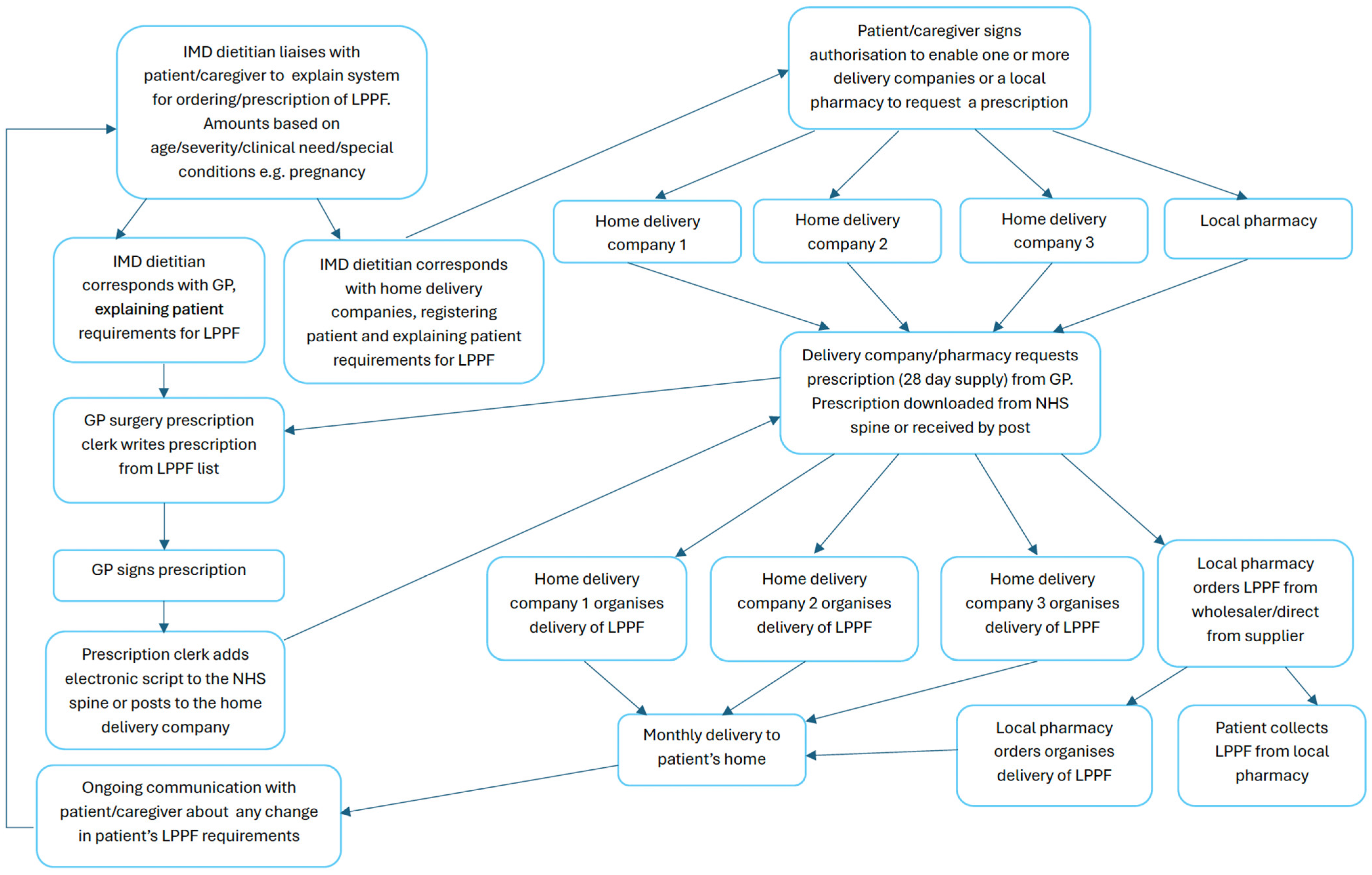
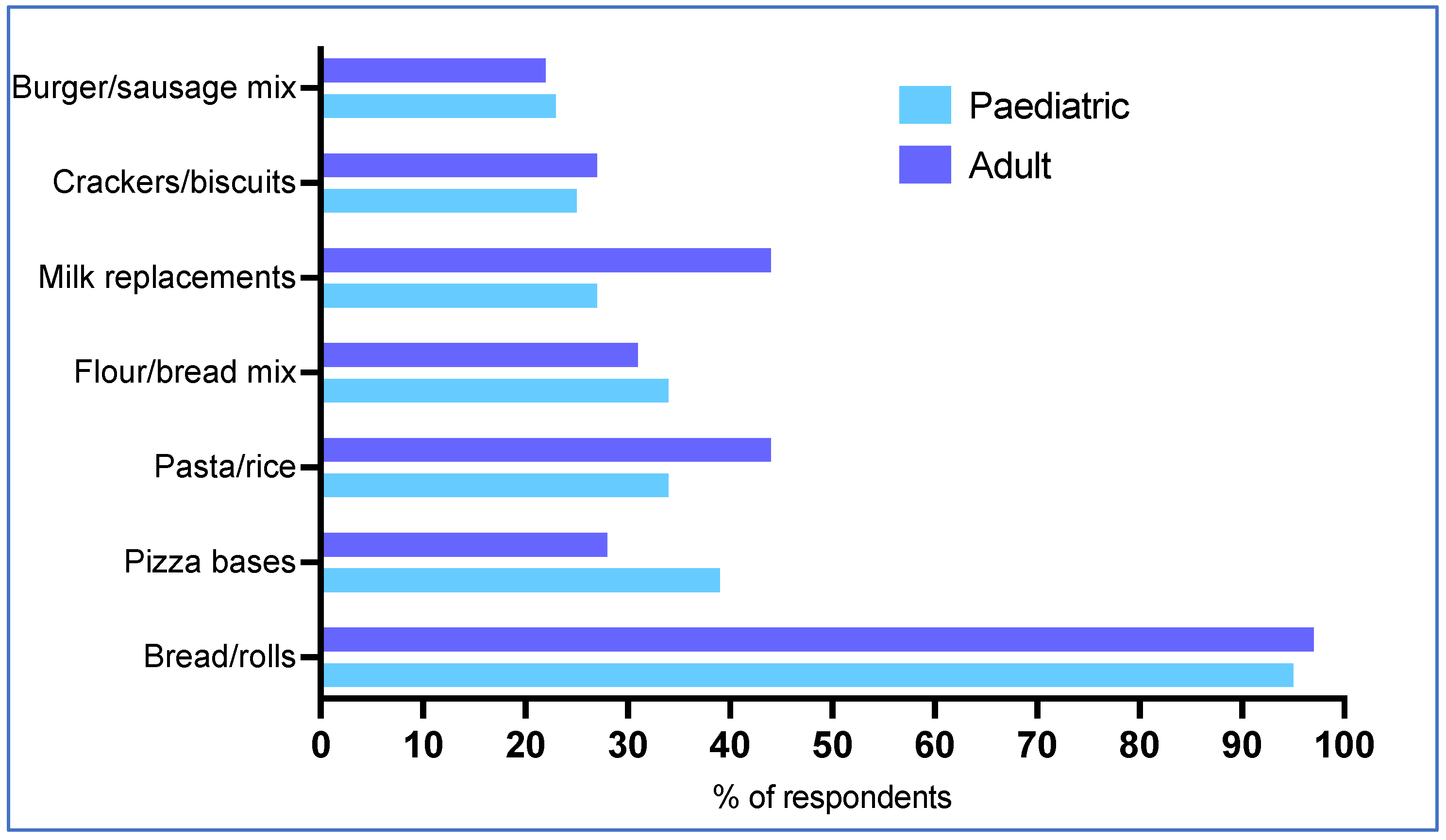
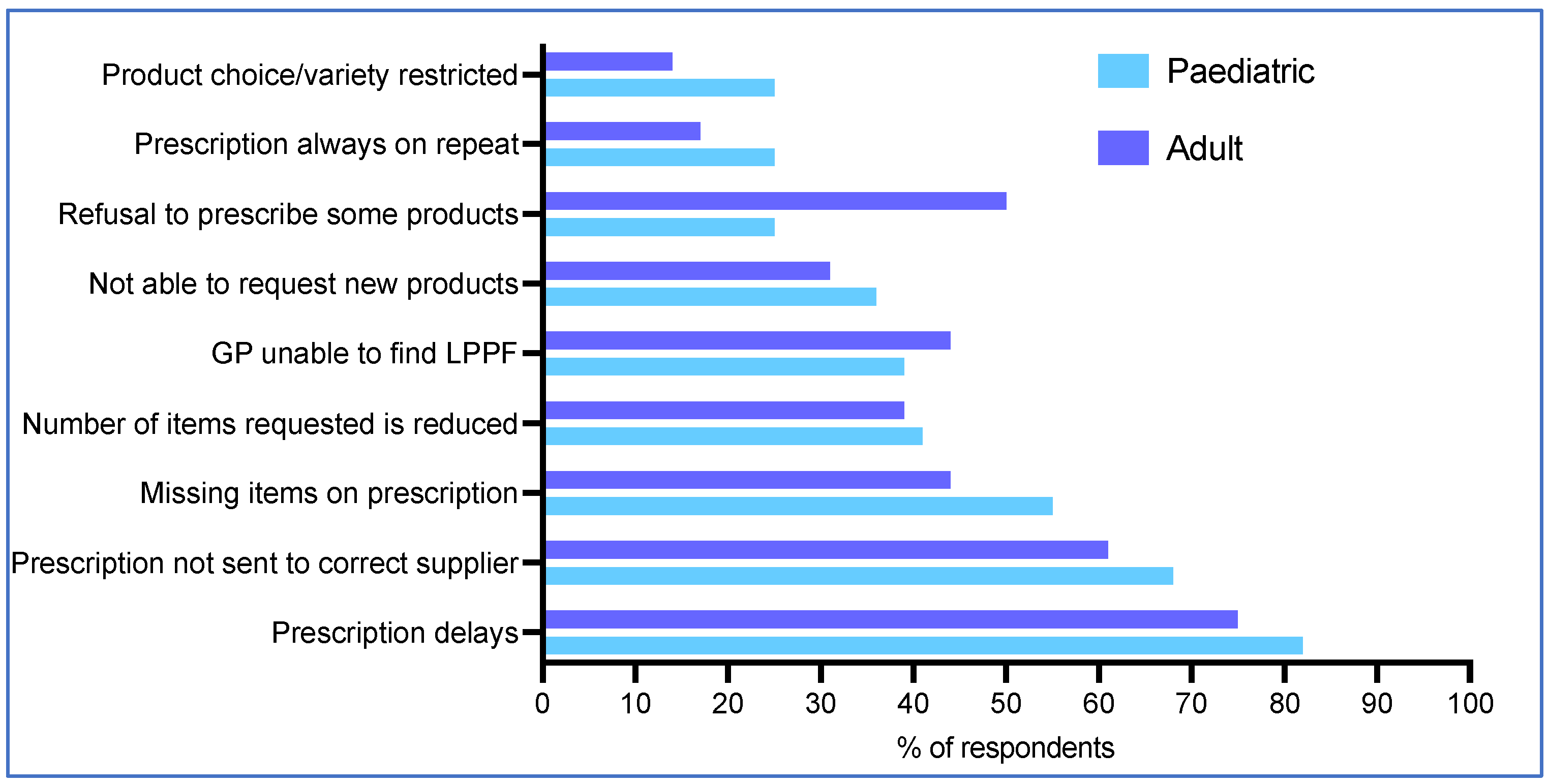
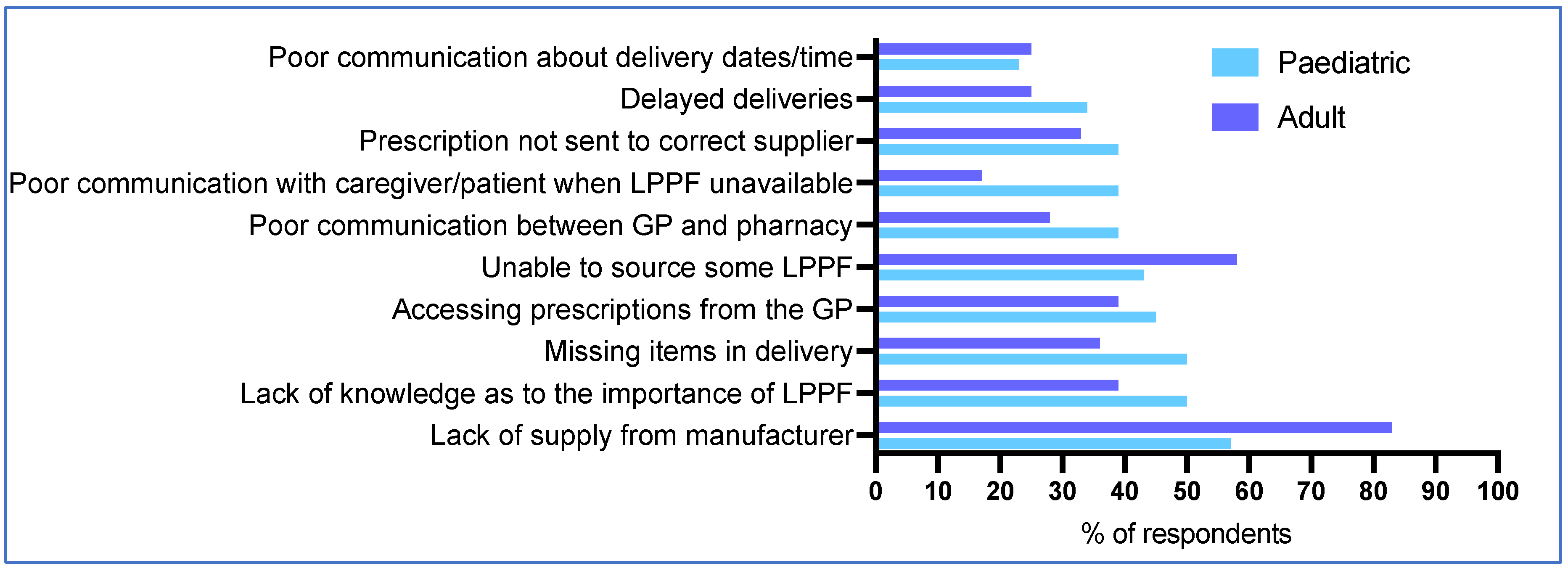
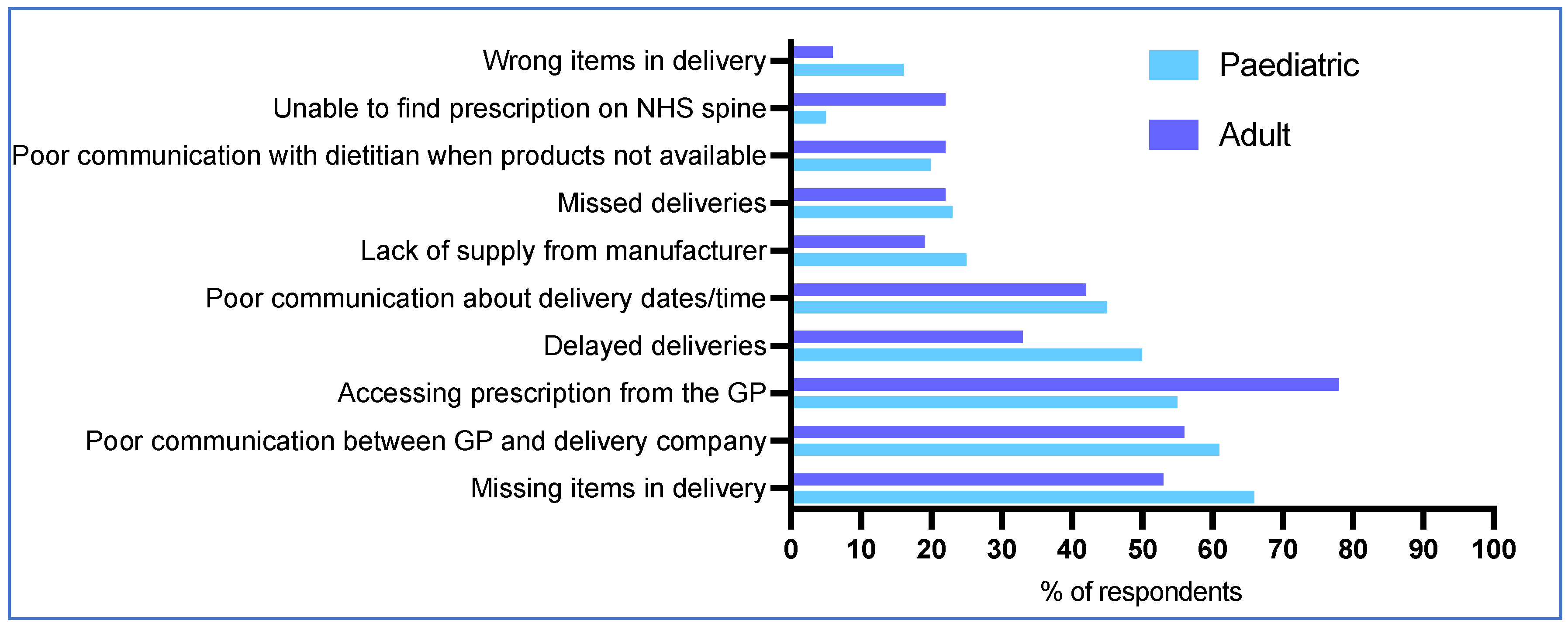

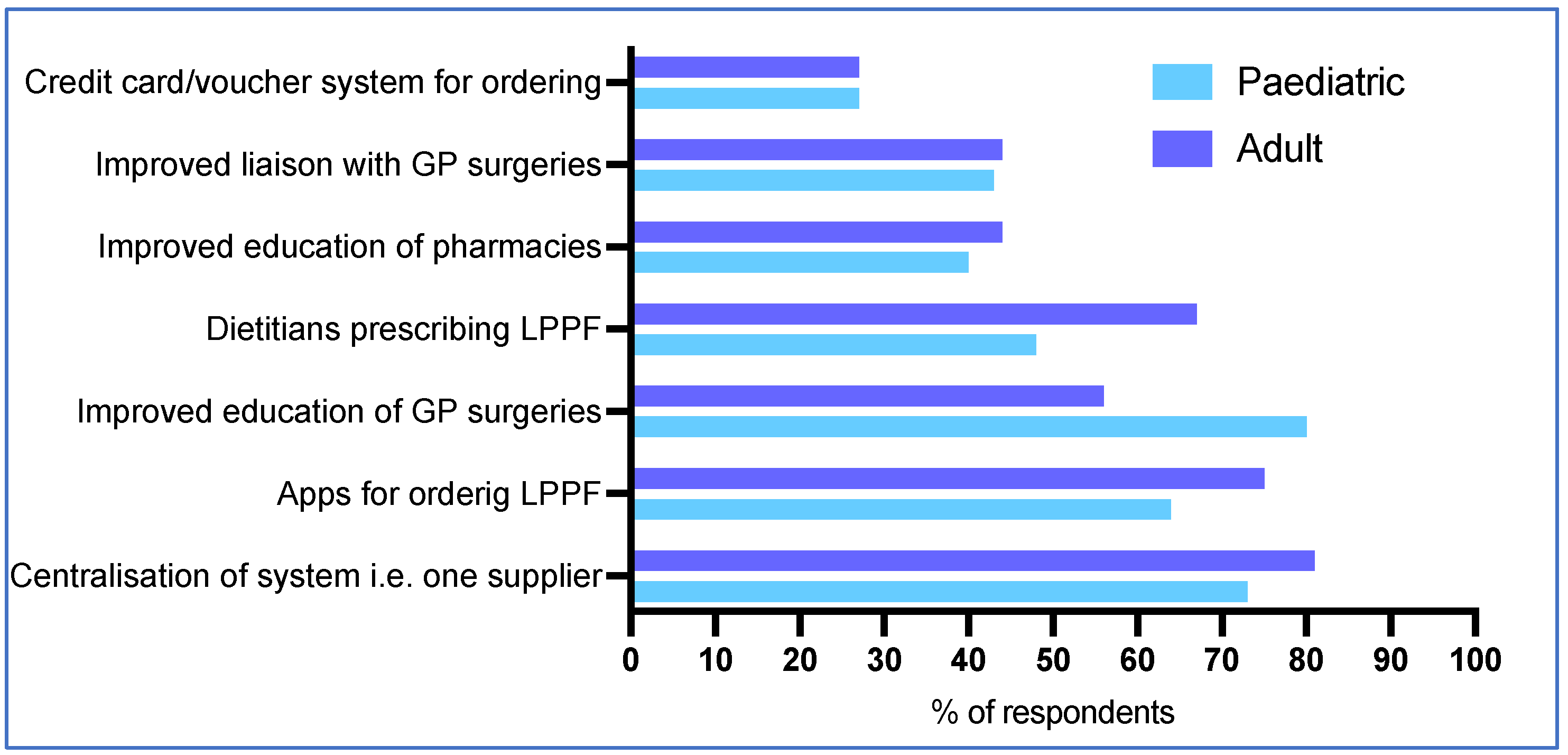
| Questionnaire Topics: |
|---|
|
| Hours/Week | Organising LPPF n(%) | p Value * | Correcting LPPF Problems n (%) | p Value * | ||
|---|---|---|---|---|---|---|
| Paediatric | Adult | 0.08 | Paediatric | Adult | 0.09 | |
| <1 h | 13 (30) | 13 (36) | 12 (27) | 19 (53) | ||
| 1–2 h | 15 (34) | 16 (44) | 21 (48) | 9 (25) | ||
| 3–5 h | 12 (27) | 2 (6) | 7 (16) | 4 (11) | ||
| >5 h | 4 (9) | 5 (14) | 4 (9) | 4 (11) | ||
| Contact Issue | At Least Weekly | Every 2 Weeks | Once a Month | Rarely | Unaware It Is an Issue |
|---|---|---|---|---|---|
| Manufacturer delays | 6 (8) | 11 (14) | 31 (39) | 31 (39) | 1 (1) |
| GP prescription issues | 30 (38) | 25 (31) | 21 (26) | 4 (5) | 0 (0) |
| GP prescription refusal | 10 (13) | 15 (19) | 13(16) | 24(43) | 8 (10) |
| Pharmacy issues | 20 (25) | 25 (31) | 33 (41) | 2 (3) | 0 (0) |
| Delivery company issues | 22 (28) | 24 (30) | 19 (24) | 14 (18) | 0 (0) |
| Issues | Supporting Respondent Quotes |
|---|---|
Prescription charges
| I worry for when patients become adults and how having to pay prescription charges may affect compliance to the very low-protein diet [English response]. Causes a lot of confusion for those turning 18 [English response]. Prescriptions are free for all ages in Scotland. It does however cause issues with the home delivery companies who all have dispensing pharmacies based in England [Scottish response]. Adults in Wales are not eligible for some home delivery services, unless they pay a pre-payment prescription. As they get their prescriptions for free, most are reluctant to do this. LP foods predominantly supplied by local pharmacy [Welsh response]. In Northern Ireland, prescriptions do not go via ’the electronic spine’ and need to be sent via post—there are often issues with prescriptions going to the wrong place/getting lost [Northern Ireland response]. |
Dispensing of low-protein prescription foods
| It is difficult for families to understand the prescribing process and know who/when to contact if there are problems. It varies from patient to patient depending on how organised they are, how good their pharmacy is and the range of products the child accepts. Having different suppliers of low-protein prescription foods is confusing for families, GPs and pharmacists. It can lead to prescription requests being sent to the wrong pharmacy or home delivery company and this ultimately results in a delay in the time it takes for patients to receive their low-protein foods. This can then have a knock-on effect on compliance as these patients cannot just go and buy these foods from the local supermarket. Adult patients need to be at home to accept deliveries. Most GPs seem to operate a single nominated pharmacy policy and this causes so many problems getting the prescriptions to the right company/pharmacy, so patients can no longer have three different home delivery companies and get non-PKU related items from the local pharmacy. |
Time dealing with low-protein prescription food issues
| It is so time-consuming sorting out problems with low-protein prescription deliveries. Sometimes the prescription issue is resolved, then after a few months, the issue arises again. I feel for the patients and the families as it is time-consuming for them and a big additional burden to try and resolve their low-protein food prescription issues. A lot of dietetic time is spent ringing and waiting on hold at GP surgeries and being the go-between for communication with GPs, delivery companies and patients. |
Pharmacy issues
| Often patients report: “pharmacy says that product is out-of-stock/product discontinued” when actually the pharmacy are trying to order from the wrong wholesaler or haven’t tried an alternative wholesaler. A high street pharmacy will say an item is out-of-stock or no longer manufactured, when in fact it’s that their suppliers don’t stock it and they are unwilling to order it in through other means. Often, items are missing from their order but no information is given about why items are missing. |
Home delivery company issues
| Dietitians receive a lot of emails from delivery companies asking them to liaise with GPs to organise owed prescriptions. I routinely hear of requests not being delivered by a home delivery company because they are waiting for a prescription. Have daily communications from home delivery companies stating they have not got the prescription from the GP, so they are unable to deliver. Parents need to be organised about when they should send in their order forms and keep track of when they should be expecting deliveries. If patients are unaware when the delivery is due and are not home, there is a risk of failed deliveries or damaged food if left somewhere inappropriate. |
Electronic Prescribing System (EPS)/NHS Spine
| Would hope that if delivery companies download the wrong prescription that they will put it straight back on the spine as they are aware it’s not for them. This is not always the case with local pharmacies who may think it’s for them or want to dispense it. |
GP issues
| Our prescription letter has instructions for the GP on how to send the prescription to each of the home delivery companies, including via the post, spine and nominated pharmacy options. But still, they get this wrong. GPs sometimes refuse more ’luxury/convenience’ foods. GPs are sometimes suspicious the whole family are using the products to save money. Items that should be on repeat prescription (and often are listed as such on the GP system) seem to ‘drop off’ and then have to be re-requested. GPs often struggle to find individual LPPFs on their system. It is difficult to explain to surgeries that patients can order any food from a long list of low-protein food items and that the prescription required will change each month. GPs do not understand the process and are confused as to where the prescription needs to be sent. Some GPs have a mistrust of home delivery companies and seem to believe that the home delivery companies are trying to rip them off. As PKU is a rare disorder, educating GP surgery staff is a relentless task due to the number of staff and staff turnover. Some GPs confuse LPPF with gluten-free foods which are available in the supermarkets. |
Contacting GP surgeries
| GP reception staff often do not have the correct training and are not sure what we are asking about. Practice pharmacists often work part-time—so it can be a week until you can speak to them. It depends on the practice. The first contact point is always the receptionist. Can be difficult to get beyond this, but I try to get put through to the person involved in prescribing. Phone lines can be extremely busy, and not all practices have dedicated prescription lines. |
Manufacturer/wholesaler issues
| Dietitians are not always made aware that there are supply issues until we are chasing up why an order has not been received. A lot of popular items have been discontinued or the supplier has been having issues obtaining the products. These items are often staples (e.g., bread products). |
* Patient/caregiver issues
| Families do not allow enough time when ordering low-protein foods—but they are expected to be very organised. For some of our vulnerable patients, we arrange a standing order of staple LPPF to ensure they always have a supply, however they may change their minds about food they enjoy Families with more than one child can find it hard to store a month’s supply of LPPF. More problems tend to be in families with communication difficulties, e.g., due to language, level of education or in areas of lower socio-economic status. Many adult patients have learning difficulties and become frustrated with the system. The current system is clunky and inefficient and causes unacceptable stress and anxiety for patients. Many find it hard to engage with their GPs / pharmacies and they feel like they’re being a nuisance having to go back and ask for something else. They often give up. Patients may come to clinic and report they haven’t had any low-protein foods for the last 3 months. Accessing low-protein foods is a barrier to adults returning or staying on diet. Patients are frequently left without staple foods such as bread due to:
|
Impact on blood Phe
| Patients running out of LPPFs can lead to high Phe levels as patients have no choice but to eat the wrong foods. It also leads to hungry patients and weight loss. If bread arrives mouldy or not at all, they may have to use supermarket gluten-free options, which are higher in protein. Adult patients can become demotivated by poor product access. Often impacts blood Phe levels as adult patients can go on/off diet depending on what stock they have available. Some patients make do and only tell you when blood Phe levels are high that they have not been getting basic low-protein foods. |
| Suggestions for Improvement |
|---|
|
Disclaimer/Publisher’s Note: The statements, opinions and data contained in all publications are solely those of the individual author(s) and contributor(s) and not of MDPI and/or the editor(s). MDPI and/or the editor(s) disclaim responsibility for any injury to people or property resulting from any ideas, methods, instructions or products referred to in the content. |
© 2025 by the authors. Licensee MDPI, Basel, Switzerland. This article is an open access article distributed under the terms and conditions of the Creative Commons Attribution (CC BY) license (https://creativecommons.org/licenses/by/4.0/).
Share and Cite
Evans, S.; Arbuckle, C.; Ashmore, C.; Bailey, S.; Blaauw, G.; Chaudhry, W.; Dale, C.; Daly, A.; Downey, B.; Dundas, J.; et al. UK Patient Access to Low-Protein Prescription Foods in Phenylketonuria (PKU): An Uneasy Path. Nutrients 2025, 17, 392. https://doi.org/10.3390/nu17030392
Evans S, Arbuckle C, Ashmore C, Bailey S, Blaauw G, Chaudhry W, Dale C, Daly A, Downey B, Dundas J, et al. UK Patient Access to Low-Protein Prescription Foods in Phenylketonuria (PKU): An Uneasy Path. Nutrients. 2025; 17(3):392. https://doi.org/10.3390/nu17030392
Chicago/Turabian StyleEvans, Sharon, Cameron Arbuckle, Catherine Ashmore, Sarah Bailey, Giana Blaauw, Wahid Chaudhry, Clare Dale, Anne Daly, Breanna Downey, Jane Dundas, and et al. 2025. "UK Patient Access to Low-Protein Prescription Foods in Phenylketonuria (PKU): An Uneasy Path" Nutrients 17, no. 3: 392. https://doi.org/10.3390/nu17030392
APA StyleEvans, S., Arbuckle, C., Ashmore, C., Bailey, S., Blaauw, G., Chaudhry, W., Dale, C., Daly, A., Downey, B., Dundas, J., Ellerton, C., Ford, S., Gaff, L., Gribben, J., Grimsley, A., Hill, M., Murphy, L., Newby, C., Oxley, N., ... MacDonald, A. (2025). UK Patient Access to Low-Protein Prescription Foods in Phenylketonuria (PKU): An Uneasy Path. Nutrients, 17(3), 392. https://doi.org/10.3390/nu17030392







